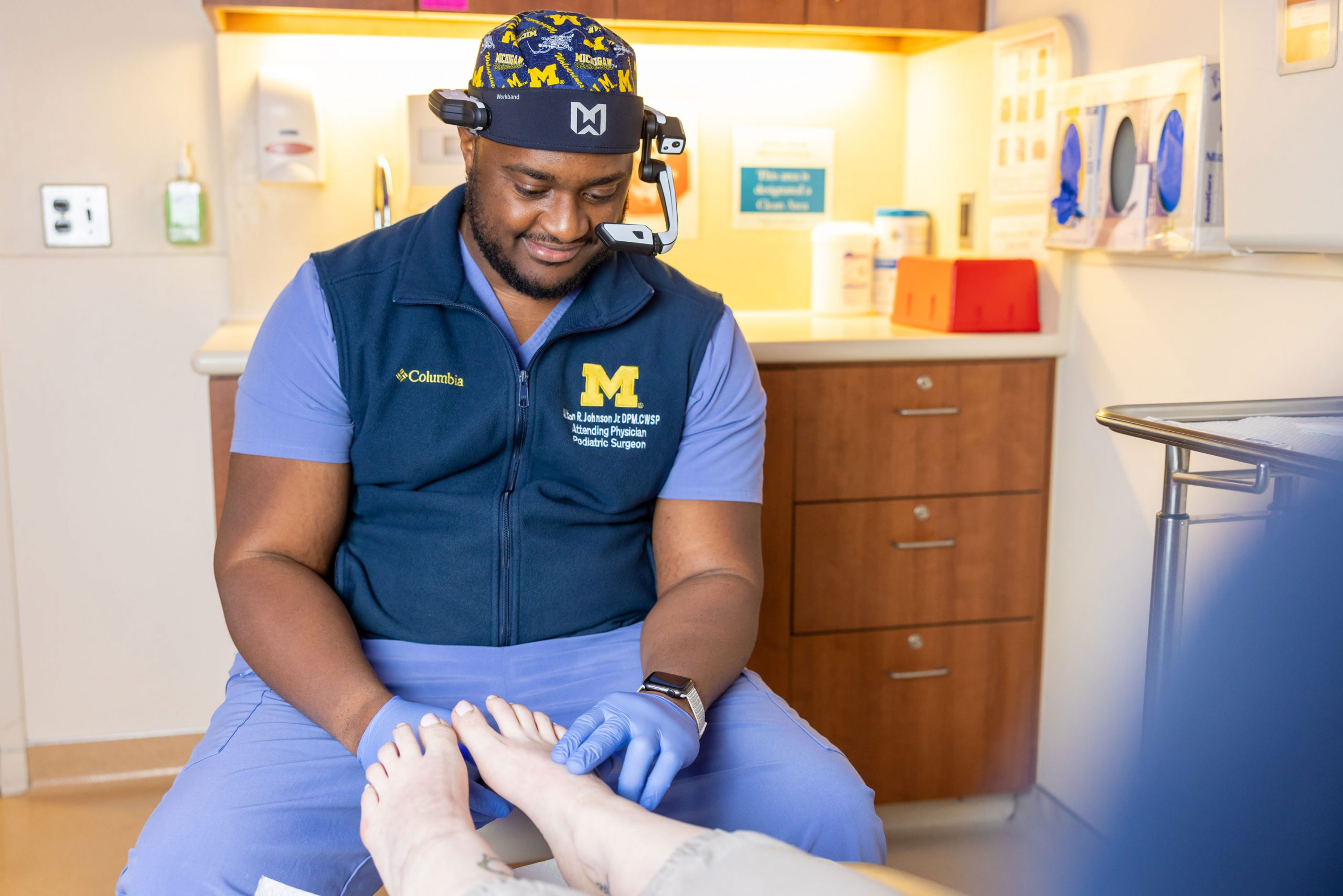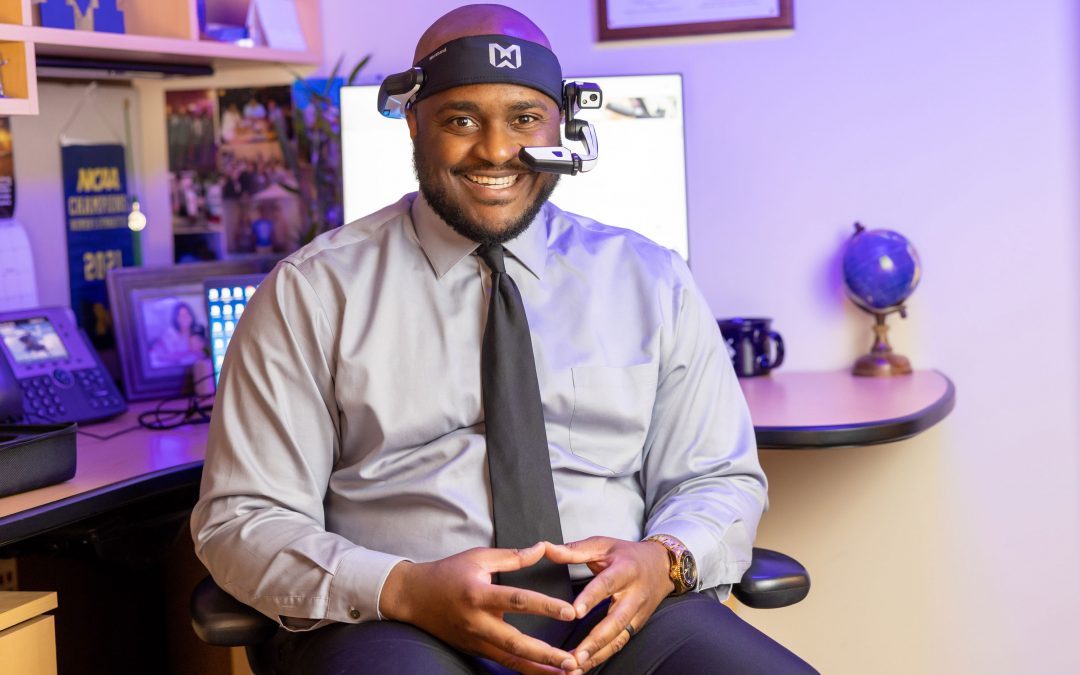Alton R. Johnson Jr., D.P.M., is participating in the RISE Innovation Development Program to develop Mi-VEST (Michigan Virtual Examination for Skills Training), a tool that teaches learners how to perform a diabetic foot examination using augmented reality.
In his practice as a podiatrist, surgeon, and wound care specialist, Alton R. Johnson Jr., D.P.M., sees a high percentage of patients with diabetes who seek care for things such as neuropathy, vascular complications, or chronic wounds associated with the diabetic foot.
Johnson, a Clinical Assistant Professor in the Department of Orthopaedic Surgery, is also an educator who works with learners across Michigan Medicine. Due to the high population of patients with diabetes that he treats, his rotation often hosts medical students, residents and fellows from areas such as Internal Medicine, Family Medicine and Endocrinology who are learning to perform diabetic foot examinations.
Johnson is hoping that his health education innovation, Michigan Virtual Examination for Skills Training or Mi-VEST, will help learners develop the skills to treat this population through the use of an interactive, augmented reality (AR) device.
“I want to incorporate Mi-VEST so I can teach people who are not podiatrists, or who are medical students or residents, how to perform a diabetic foot exam,” said Johnson. “It’s kind of hard to get someone who’s already practicing to learn something new, but you can get someone who’s specifically coming to your rotation to learn a new skill set.”
The Initial Idea
Through one of his mentors, Johnson learned about a wearable device that incorporates AR to connect physicians to experts, typically in a telehealth setting. He realized that this device, known as the Head Mounted Tablet or HMT-1, could have applications to training and education and eagerly worked to acquire one to use in his clinic.
His initial idea involved creating a curriculum of first person videos that learners could watch to review procedures and surgeries. “I started bringing the device to clinic and recording videos of myself using it. Everyone was looking at me and calling me a Marvel superhero,” shared Johnson.
The makers of the device, Hippo Virtual Care, then introduced him to the virtual checklist feature. This feature allowed Johnson to build a customized checklist within the device’s software that could walk a physician wearing the device through each step of the exam. As they progress, a visual checklist appears via the viewfinder connected to the head-mounted computer, allowing the user to see both the virtual checklist in real time as well as the surrounding environment, ensuring no steps are skipped.

Dr. Alton Johnson Jr. performs a diabetic foot exam using Mi-VEST, an augmented reality tool.
Johnson was thinking about piloting the device and what his next steps might look like when a University of Michigan medical student on her rotation suggested that he look into RISE. Johnson was unfamiliar with RISE, but his interest was piqued. He spent the next few hours exploring the RISE website, learning all he could about the resources available, the Innovation Development Program and past participants. He recognized the name of a former RISE Innovator and reached out to learn more about her experience before deciding to apply.
RISE’s Impact
Once he was accepted into the Innovation Development Program, he started benefiting from the program right away. Like many people at Michigan Medicine, Johnson keeps a busy schedule, and having things like protected time helped him focus on his project. “Just having that protected time itself helped accelerate something that would have taken me probably six months to a year. I started getting it done in one month.”
Through the monthly workshops, RISE has also helped Johnson to focus his vision for how to best use the device. Originally thinking he would cover multiple podiatry topics, RISE helped him to narrow his focus to the diabetic foot exam based on what learners were asking about the most. “I realized that you can’t go at the entire pie, you have to go at the slices, take incremental steps to get up to the complete vision. Before I thought I could just do it all, because I thought that was the way you’re supposed to do it, but RISE showed me you have to have a strategic plan” Johnson shared.
RISE is also helping Innovators like Johnson make new connections. “They are great facilitators or networkers. If they don’t know it, they can get you to someone that’s an expert on it.” For Johnson, getting connected with the XR Initiative through the Center for Academic Innovation helped him get additional support in areas like security, something especially important for when he begins integrating patient information. Johnson also received assistance from a medical librarian who helped him conduct a literature review on using augmented reality in education.
Johnson would recommend RISE to colleagues looking for support for their education innovation ideas. “When people ask me about RISE, I always say it’s like a medical health education think tank. You have a bunch of different academic based professionals and we try to think of ways to make our ideas more scalable and utilize the time that we have to execute them.”
Next Steps
While Johnson’s project first envisioned Mi-VEST for physician use, there could be interprofessional applications as well. One idea involves training visiting nurses to use Mi-VEST to aid with triaging homebound patients at risk of diabetic foot complications. “This could help identify high-risk patients that are not able to get to clinics regularly to see their primary doctors, and could warrant an expedited referral or recommendation to a lower extremity specialist,” said Johnson.
Johnson is hoping that over time, his project will help contribute to better outcomes for patients. “My device is a train and treat model. You’re training an individual or a learner and you are also treating patients. The goal is to see if incorporating augmented reality into medical education decreases morbidity and mortality. If so, then I think the project will be a success.”
To stay informed about RISE opportunities and education innovation happening at Michigan Medicine, join our community.
Photo credits: Camren Clouthier
